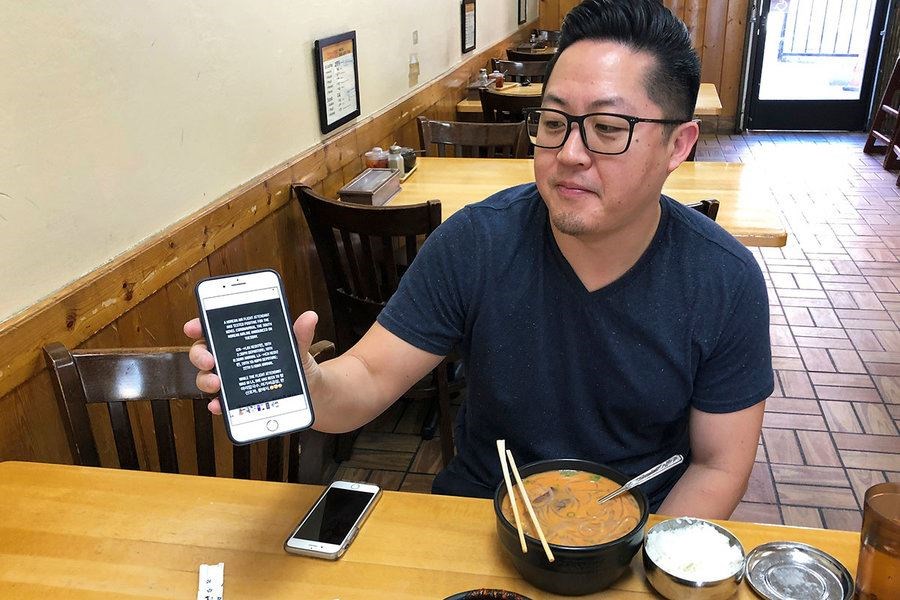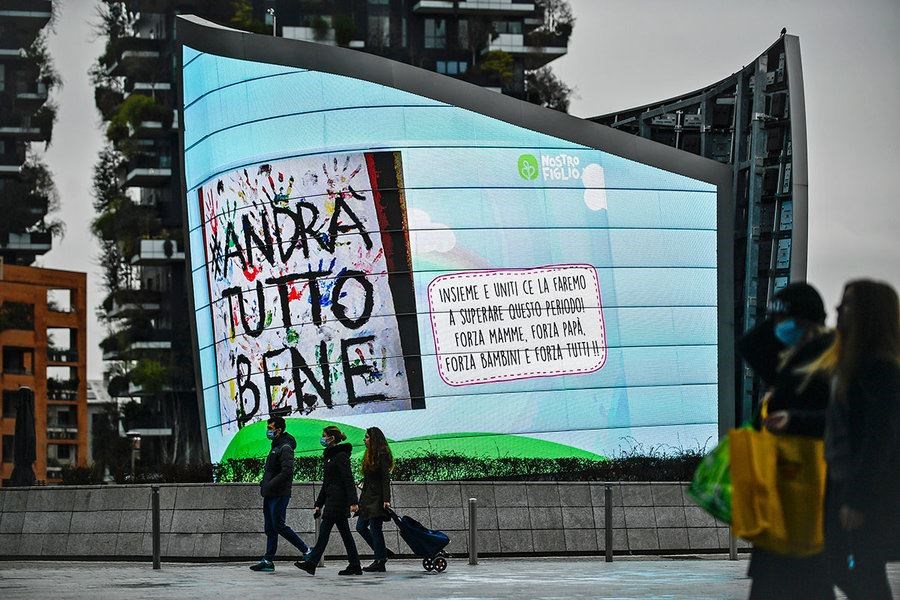REPRINTED WITH PERMISSION FROM THE CHRISTIAN SCIENCE MONITOR
The first pandemic of the social media era has brought a parallel set of challenges, including the rapid spread of fear and false information. Here’s how people are working to address that.
MARCH 17, 2020 - One thing quarantines can’t stop is the spread of false information and fear on Facebook and other popular platforms. In the world’s first social media pandemic, that presents a parallel set of challenges for citizens and leaders alike.
 Alex Won shows the message that spread the rumor on social media, while he was eating at Han Bat Shul Lung Tang restaurant in Los Angeles on Feb. 28, 2020. Han Bat Shul Lung Tang was one of five restaurants that los business after being named in posts on a Korean Messaging app that warned a Korean Air flight attendant with the virus had dined there during a layover in Los Angeles more than a week ago. “It’s fake news,” the restaurant owner John Kim said, and he had proof. His restaurant was closed at the time because of a water leak, a fact confirmed by the Department of Public Health.Brian Melley/AP
Alex Won shows the message that spread the rumor on social media, while he was eating at Han Bat Shul Lung Tang restaurant in Los Angeles on Feb. 28, 2020. Han Bat Shul Lung Tang was one of five restaurants that los business after being named in posts on a Korean Messaging app that warned a Korean Air flight attendant with the virus had dined there during a layover in Los Angeles more than a week ago. “It’s fake news,” the restaurant owner John Kim said, and he had proof. His restaurant was closed at the time because of a water leak, a fact confirmed by the Department of Public Health.Brian Melley/AP
Many have found social media an effective tool for rapidly conveying official guidelines and recommended practices, as well as for connecting with each other and supporting the most vulnerable in society. But mixed in has been a torrent of misguided advice and inaccurate claims – including from supposedly scientific studies. This false information has amplified concerns in ways that have made it difficult to ascertain clearly the scope of the global health challenge and how best to address it.
The director-general of the World Health Organization has called on governments, companies, and news outlets around the globe to tackle an “infodemic” of fake news, which he characterized as being as dangerous as the coronavirus itself. The U.S. State Department’s foreign propaganda-busting center has compiled a report on some 2 million tweets spreading conspiracy theories about the epidemic, concluding that at least some of the activity was due to coordinated campaigns involving fake accounts, according to The Washington Post. And amid the swirl of dire predictions, a microbiology professor in Spain has deemed this a “pandemic of fear.”
Indeed, fear and false information have gone viral. Everyone from data scientists and doctors to psychologists and pastors are weighing in on how to contain this infodemic and its attendant effects. Many see an opportunity for society and individuals to come out of this crisis the stronger for it.
“Sometimes a crisis can give us a lot of fear but it can also prompt us to think deeper and to think better,” says Kristen Lee, a behavioral science professor at Northeastern University in Boston who cautions against “hype contagion.”
To avoid the sometimes paralyzing effects of fear, she advocates limiting social media consumption and finding opportunities to help others and live in a purpose-driven way. “When we’re using our skills, resources, and capacities to contribute to the betterment of society,” Dr. Lee says, “that really is known to elevate and protect our well-being through times of difficulty.”
Carl Bergstrom, a biologist at the University of Washington, says half-jokingly that he was “pre-designed” for this crisis, with a background in studying novel infectious diseases as well as how information spreads through networks from ant colonies to Facebook.
 People walk past a billboard reading "Andra tutto bene," which is Italian for "Everything will be alright," in Milan, Italy. Amid a nationwide lockdown to slow the spread of the coronavirus, Italians are finding ways to come together virtually in solidarity. This week, children’s drawings of rainbows are appearing all over social media as well as on balconies and windows in major citiesClaudio Furlan/LaPresse/AP .
People walk past a billboard reading "Andra tutto bene," which is Italian for "Everything will be alright," in Milan, Italy. Amid a nationwide lockdown to slow the spread of the coronavirus, Italians are finding ways to come together virtually in solidarity. This week, children’s drawings of rainbows are appearing all over social media as well as on balconies and windows in major citiesClaudio Furlan/LaPresse/AP .
As he’s monitored false information online about COVID-19, he’s seen everything from anti-China conspiracy theories including the intentional development of coronavirus as a bioweapon to “snake-oil salesmen” peddling fake cures. Those cures have included special toothpaste and potions, prompting a spoof from comedian John Oliver who offered “Premium Werewolf Solution” for $49.99.
One of the challenges of combating false information is the underlying architecture of social media and the algorithms that drive it.
“What goes viral doesn’t have a lot to do with what’s true, it has to do with what’s shocking,” says Professor Bergstrom, who commends social media companies for trying to prevent misinformation from spreading on their platforms. “On the one hand, kudos to them for doing that. On the other hand, the problem exists in an ecosystem of their making.”
In addition to the often well-intentioned sharing of unverified information that turns out to be false, another threat is organized disinformation campaigns designed to distract, distort, and deceive.
When the crisis ramped up last week, there was a four- to five-day window in which official communication channels were relatively unfettered by such campaigns, says Marc Ambinder, a digital fellow at the University of Southern California studying disinformation and cybersecurity around elections. But, he adds, if the number of cases spikes, “there’s going to be more anxiety, and the purveyors of disinformation in this arms race are going to regain their footing very quickly.”
The Trump administration has alleged that a foreign disinformation campaign is underway to sow fear. This past weekend, the National Security Council tweeted, “Text message rumors of a national #quarantine are FAKE. There is no national lockdown.” Governors and mayors have issued similar missives. And the Pentagon has called out China for spreading “false & absurd conspiracy theories about the origin of COVID-19 blaming U.S. service members.”
An internal European Union document describes a “significant disinformation campaign by Russian state media and pro-Kremlin outlets regarding COVID-19” in numerous languages designed to “exacerbate confusion, panic and fear” and thereby undermine public trust in authorities and national health care systems. Messages in Spanish, for example, “advance apocalyptic stories, blame capitalists for trying to benefit from the virus, and emphasise how well Russia and [President Vladimir] Putin are dealing with the outbreak,” according to a Financial Times report.
Nicholas Christakis, a physician and sociologist at Yale who has become a prominent voice on COVID-19, complained on Twitter of having gained the unwanted attention of lots of Russian bots. “Their intent seems to be to waste my time. Their psychological tricks are incredible,” he wrote.
Toomas Hendrik Ilves, the former president of Estonia, which is a leader in countering disinformation, responded that attempts to disrupt, disinform, and dismay are par for the course. He tweeted back, “No need to interact. Block.”
In this turgid information environment, it has been difficult for leaders to find “a healthy balance between conveying calm and being frank about troubling facts,” as former Treasury Secretary Henry Paulson Jr. advised in a Washington Post op-ed last week. Imparting lessons he learned from helping to steer the nation through the 2008 economic crisis, he called fear “as big an enemy as the virus itself.”
To be sure, minimizing or ignoring information from official sources carries its own dangers, and there is disagreement about what constitutes an “appropriate” level of fear. Some say fear spurs people into necessary action. But it can also lead to poor decision-making and unnecessary worry, and negatively affect one’s health.
“After working for 45 years in the field of psychiatry, I have seen fear cause a lot of long-term consequences in people’s lives,” says Dr. Mary Moller, associate professor of nursing at Pacific Lutheran University in Washington and the 2018 American Psychiatric Nurses Association’s Psychiatric Nurse of the Year. “Ultimately, over time, it can lead to compromising your immune system.”
In addition to mental health professionals’ efforts to help people address their fears, faith leaders are also pointing seekers to spiritual sources and encouraging them to minister to their neighbors.
“There’s not only a physical toll but there’s a psychological, emotional, and spiritual toll that we need to be aware of and we need to pray through,” says Derwin Gray, lead elder-pastor of Transformation Church in Indian Land, South Carolina, citing scriptural promises of reassurance. “When we are serving other people’s needs, that’s when we tend to be the most healthy.”
Coming together to work through this crisis could be a catalyst for human progress, says virologist Anjeanette Roberts, who worked on SARS for three years and serves as a research scholar with Reasons to Believe.
“It’s the crises that have the ability to bring out the very best in us because it makes us lay aside what we tend to focus on that can divide us,” says Dr. Roberts, a public advocate of her Christian faith who is deeply concerned about the level of polarization in American society today. “We have gotten really far away from the idea of ‘Do unto others as you would have them do unto you.’”
Now, with a global health challenge that has neighbors leaning out their windows and singing together, younger people going grocery shopping for their older neighbors, little kids leaving drawings in every mailbox in their neighborhood, and many other examples of people helping each other, some see an opportunity not only to survive the crisis but come out stronger for it.
Pastor Gray says, “I think it’s putting us in a place of saying, ‘Wow, maybe I do need a hope and a power and a strength and a love that is beyond me.’”
Page created on 3/31/2020 11:50:00 AM
Last edited 4/1/2020 2:05:27 AM
